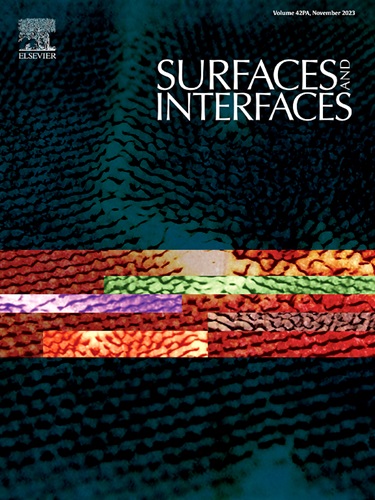3D TiO2-x and Ag10Si4O13 nanoparticals embedded into 2D thin layer g-C3N4 to construct 3D/2D/3D double Z‐scheme heterojunction for enhanced photocatalytic activity and stability
IF 5.7
2区 材料科学
Q2 CHEMISTRY, PHYSICAL
引用次数: 0
Abstract
The construction of heterojunction photocatalytic materials based on semiconductors for environmental remediation has attracted much attention. In this study, an accurate molecular (ion) scale assembly based on two-step sol-gel method was used to achieve the controllable preparation of 3D/2D/3D double Z‐scheme oxygen-deficient TiO2 (TiO2-x)/g-C3N4/Ag10Si4O13 (CTA) heterojunction photocatalyst. The double heterojunction structure increased the photogenerated carrier separation efficiency, enhanced the redox ability and extended the photoresponse range to 701 nm, which significantly improves the photocatalytic activity. As a result, under simulated sunlight and visible light irradiation conditions, the degradation efficiency of CTA (0.5:1) samples for tetracycline hydrochloride (TCH) within 60 min reached 90 % and 86 %, and respectively. In addition, the photocorrosion resistance of Ag10Si4O13 was greatly improved by using heterojunctions to control photogenerated electrons migrate from the Ag10Si4O13 conduction band to the g-C3N4 valence band, and the CTA showed excellent cyclic service stability. The novel nanostructure control strategy provided an important reference for highly active and stable photocatalysts.

基于半导体的异质结光催化材料在环境修复领域的应用备受关注。本研究采用基于两步溶胶-凝胶法的精确分子(离子)尺度组装技术,实现了3D/2D/3D双Z型缺氧TiO2(TiO2-x)/g-C3N4/Ag10Si4O13(CTA)异质结光催化剂的可控制备。双异质结结构提高了光生载流子分离效率,增强了氧化还原能力,并将光响应范围扩展至 701 纳米,从而显著提高了光催化活性。因此,在模拟太阳光和可见光照射条件下,CTA(0.5:1)样品在 60 分钟内对盐酸四环素(TCH)的降解效率分别达到 90% 和 86%。此外,通过使用异质结控制光生电子从 Ag10Si4O13 的导带迁移到 g-C3N4 的价带,Ag10Si4O13 的抗光腐蚀性能得到了极大的改善,并且 CTA 表现出了优异的循环使用稳定性。新颖的纳米结构控制策略为高活性、高稳定性光催化剂提供了重要参考。
本文章由计算机程序翻译,如有差异,请以英文原文为准。
求助全文
约1分钟内获得全文
求助全文
来源期刊

Surfaces and Interfaces
Chemistry-General Chemistry
CiteScore
8.50
自引率
6.50%
发文量
753
审稿时长
35 days
期刊介绍:
The aim of the journal is to provide a respectful outlet for ''sound science'' papers in all research areas on surfaces and interfaces. We define sound science papers as papers that describe new and well-executed research, but that do not necessarily provide brand new insights or are merely a description of research results.
Surfaces and Interfaces publishes research papers in all fields of surface science which may not always find the right home on first submission to our Elsevier sister journals (Applied Surface, Surface and Coatings Technology, Thin Solid Films)
 求助内容:
求助内容: 应助结果提醒方式:
应助结果提醒方式:


